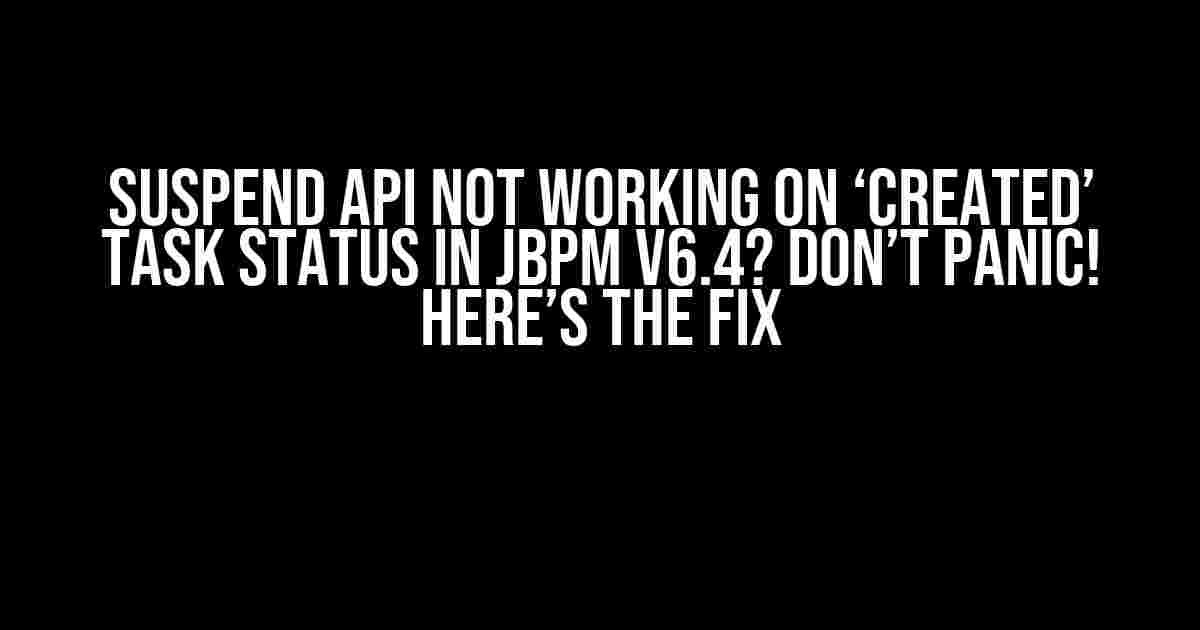If you’re reading this, chances are you’re frustrated with the Suspend API not working as expected on tasks with a ‘Created’ status in JBPM V6.4. You’re not alone! This pesky issue has been driving many developers crazy, but fear not, dear reader, for we’ve got the solution right here.
What’s the Problem?
Before we dive into the solution, let’s quickly understand the problem. In JBPM V6.4, when you try to suspend a task using the Suspend API, it doesn’t work as expected when the task status is ‘Created’. This can be a major roadblock, especially if you’re relying on this API to manage your workflow.
Note: This issue is specific to JBPM V6.4. If you're using a different version, you might not face this problem.
Why is this Happening?
So, what’s causing this issue? The root of the problem lies in the way JBPM handles tasks with a ‘Created’ status. When a task is created, it’s not yet activated, which means it’s not eligible for suspension. The Suspend API, by design, only works on active tasks.
Think of it like this: when you create a task, it’s like putting a car in park. You can’t shift it into gear until you’ve started the engine, right? Similarly, a task with a ‘Created’ status is like a car in park, and the Suspend API is like trying to shift into gear before starting the engine.
The Fix
Now that we understand the problem, let’s get to the solution. To suspend a task with a ‘Created’ status, you need to activate the task first. Yes, you read that right – activate the task before suspending it. It might seem counterintuitive, but trust us, it works like a charm!
Step 1: Activate the Task
Use the following code to activate the task:
“`java
TaskService taskService = (TaskService) ProcessRuntime.getRuntimeManager(session).getTaskService();
taskService.activate(taskId, session);
“`
Replace `taskId` with the actual ID of the task you want to suspend, and `session` with your active session.
Note: Make sure you have the correct imports and dependencies in your project.
Step 2: Suspend the Task
Once the task is activated, you can suspend it using the Suspend API:
“`java
taskService.suspend(taskId, session);
“`
Again, replace `taskId` with the actual ID of the task, and `session` with your active session.
Putting it All Together
Here’s the complete code snippet:
“`java
TaskService taskService = (TaskService) ProcessRuntime.getRuntimeManager(session).getTaskService();
// Activate the task
taskService.activate(taskId, session);
// Suspend the task
taskService.suspend(taskId, session);
“`
Voilà! You’ve successfully activated and suspended the task using the Suspend API.
Troubleshooting Tips
If you’re still facing issues, here are some troubleshooting tips to help you out:
- Check your task status: Ensure that the task status is indeed ‘Created’ before trying to suspend it.
- Verify your session: Make sure you’re using an active session and that it’s not expired.
- Check your imports: Ensure you have the correct imports and dependencies in your project.
- Consult the JBPM documentation: If you’re still stuck, refer to the official JBPM documentation for more information on the Suspend API.
Conclusion
In conclusion, the Suspend API not working on ‘Created’ task status in JBPM V6.4 is a common problem that can be easily fixed by activating the task first. By following the steps outlined in this article, you should be able to suspend tasks with a ‘Created’ status without any issues.
Remember, activating the task before suspending it is the key to unlocking this functionality. So, the next time you encounter this issue, don’t panic – just activate and suspend!
| Problem | Solution |
|---|---|
| Suspend API not working on ‘Created’ task status | Activate the task before suspending it |
We hope this article has helped you solve the Suspend API issue in JBPM V6.4. If you have any more questions or need further assistance, feel free to ask in the comments below.
Happy coding!
Here are 5 Questions and Answers about “Suspend API not working on ‘Created’ Task Status in JBPM V6.4”:
Frequently Asked Question
Get the answers to the most pressing questions about Suspend API not working on ‘Created’ Task Status in JBPM V6.4
Why is the Suspend API not working on ‘Created’ Task Status in JBPM V6.4?
The Suspend API is not designed to work on tasks with a status of ‘Created’. The Suspend API is meant to pause tasks that are currently in progress or waiting for a resource. Since a task with a status of ‘Created’ is not yet in progress, the Suspend API will not have any effect.
What status should the task be in for the Suspend API to work?
For the Suspend API to work, the task should be in a status of ‘Ready’ or ‘InProgress’. This is because the Suspend API is designed to pause tasks that are currently in progress or waiting for a resource, which is typically represented by these two statuses.
How can I suspend a task that has just been created?
Instead of using the Suspend API, you can use the Claim API to claim the task and then use the Release API to release the task with a status of ‘Suspended’. This will effectively suspend the task, even though it’s in a ‘Created’ status.
What are the implications of suspending a task that has just been created?
Suspending a task that has just been created may have unintended consequences, such as delaying the execution of the task or causing the task to be skipped altogether. It’s essential to carefully consider the implications of suspending a task in a ‘Created’ status before doing so.
Is there a workaround to suspend a task that has just been created using the Suspend API?
Unfortunately, there is no direct workaround to suspend a task that has just been created using the Suspend API. The Suspend API is designed to work with tasks in specific statuses, and ‘Created’ is not one of them. You’ll need to use alternative methods, such as the Claim and Release API, as mentioned earlier.

